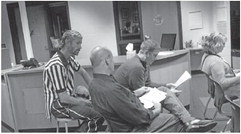Dean of students plan working as promised


Star News
Editorials
After two full months of the school year, the shared dean of students administrative model at Gilman Schools is living up to what school officials hoped it could be.
Faced with the resignation of the middle/high school principal last summer, Gilman school district was faced with a choice. Board members and administration could maintain the status quo and invest close to $100,000 a year in salary and benefits to recruit and bring in a new principal, or they could look to their staff and tap into talents that were already in the district.
Gilman district administrator Walter Leipart, with the input of staff, developed a plan that would transform the traditional building principal position into a threeperson dean of students model.
Faced with declining enrollments, Gilman, like many other small districts around the state, has struggled with recruitment and retention of qualified staff. A particular challenge is in ensuring staff members’ schedules are kept full. A major selling point of the split dean of students model is that it keeps high-quality veteran teachers in the classroom while also ensuring that administrative and student disciplinary functions are being handled in a timely and appropriate manner.
While each of the teachers who are splitting the duties are receiving additional compensation for stepping up to these roles, the overall cost to the district taxpayers is far less than what it would have been to hire someone to serve solely as a building principal.
With Gilman Schools heading to referendum next spring to ask voters to renew the ability to exceed the revenue cap for another five years, it is important to demonstrate to taxpayers that the district is being fiscally responsible while working to maintain quality education.
Faced with precipitous declining enrollment numbers, the dean of students model is one that could develop into an approach toward building governance that is less hierarchical and more collaborative in nature with the line between teachers and administration continuing to blur. The ultimate beneficiaries of this are the families in the district who can rest assured knowing that the district is using its available resources with a primary focus on education versus administration.
Gilman entered the school year under this model with the caveat that if it went wrong, the district could always back up and go with the traditional building principal model. So far, the experiment appears promising with staff and administration able to work out any kinks that have developed.
The model is being closely watched by families in the district as well as board members and administrators from other areas who are facing similar enrollment and recruitment issues. If it continues to be successful, it could serve as a model for small, cash-strapped districts as a way to keep veteran, high-performing teachers in classrooms while providing opportunities for professional growth and development.

